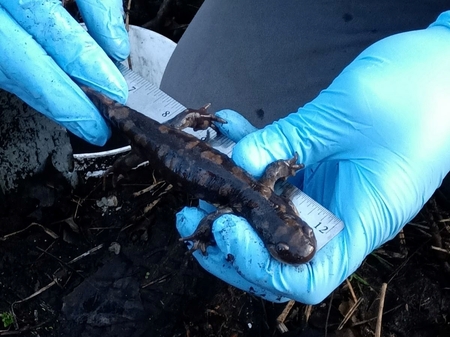
Good Natured: Salamander Season
My three-year-old self couldn't believe her eyes.
There at the bottom of a shallow window well, half hidden beneath a pile of wet, well-composted leaves, peered the most fearsomely amazing creature I'd ever seen. Black with yellow stripes, it was quite a bit longer than my two hands put together. It was also barely—tantalizingly—beyond my reach.
Finding that tiger salamander at Aunt Leora's still ranks among my top two memories at her house (the other being the time I stepped in a bucket of paint while “helping" paint the garage) and is one that will probably last a lifetime. Which is a good thing because, really, how often do you really get to see a salamander?

Secretive to downright reclusive, tiger salamanders aren't the sort of critter you'll run into over the course of an average day. As members of the genus Ambystoma, tigers are mole salamanders and, like moles, spend most of their time underneath the ground. They'll come out to forage on rainy nights but otherwise stay tucked away in their burrows.
Except for right now.
For a few weeks in late winter and early spring, tiger salamanders literally hit the trail, leaving their home sweet home (hole sweet hole?) and heading to a nearby pond to commence with some very important business: their annual breeding activities.
Unlike those other amphibians, the frogs, which use their remarkable vocal apparatus to make remarkably loud, species-specific calls, salamanders court each other silently, through…dance.
Seriously!
It's no stately waltz, but rather a sequence of moves with names like the cloaca-nudging walk and the shoving transport of the female. The choreography is crazy, but productive, and results in clumps of fertilized eggs. Whoopee!
Three Year Old Me would be absolutely ecstatic to know that 60-ish Year Old Me has actually gotten to witness parts of this annual ritual, thanks to the efforts of our restoration ecologists here at the St. Charles Park District.
Each year our lead ecologist, Ryan Solomon, rigs a series of pitfall traps in one of our diverse natural areas. Located between the salamanders' primary woodland habitat and the ephemeral ponds they use for breeding, the setup creates a brief detour for the sallies while helping Ryan gather data on this important indicator species.
Because these moist-skinned amphibians usually move at night, when humidity is up and the sun is down, it's essential that the traps (which actually are 1-gal., food-grade buckets) are checked early each morning. Ryan and his team head out at 7 a.m. and sometimes sooner to count, measure and sex the salamanders before releasing them into the dance pond.
As Ryan explains, salamanders are quite sensitive to changes in their environment. They breathe through their skin, so they (along with frogs) are among the first creatures to feel the effects of any contaminants or pollutants that might appear in their habitat.
Seeing some salamanders in an area is a good sign that an ecosystem is healthy, but seeing a lot of salamanders generally means they've found exactly what they need to thrive: clean air; clean water; plentiful food in the form of invertebrates (and sometimes, in their immature form, each other); and healthy soil for burrowing.
Being the strong, silent type, our St. Charles salamanders weren't available for comment, but if Ryan's monitoring data is any indication, Ambystoma tigrinum is doing well amid the friendly confines of our natural areas. “At the River Bulrush single trap we get about 90 (salamanders over the 4- to 6-week monitoring period)" Ryan says. “I believe 130 was our highest and last year was lower—66—but that was due mostly to odd climatic conditions." He explained that the early warm temperatures followed by sporadic periods of cold we experienced last year played a role in salamander movement, which in turn affected his team's ability to collect data.
This year has seen similar periods of ups and downs, with some crazy warm temperatures followed by cool spells and nights where the thermometer dips below freezing. Still, the salamanders march on, driven by an internal clock and an instinct that it's time to perpetuate the species.
The eggs deposited now will hatch over the ensuing weeks, and the larval salamanders will inhabit their natal pond for the next several months. They spend the summer putting on weight and inches, feeding on anything that will fit in their broad ambystomid mouths. (They're named tigers for a reason!) As fall approaches the larvae's gills give way to lungs and soon the transformation is complete. The now air-breathing, terrestrial creatures make their way up onto land and, not long after, under the ground.
There they stay, rarely, if ever, encountering inquiring humans, until they experience the undeniable urge to, um, dance. Then the cycle begins again.
If you've ever wanted to see a salamander, now's the time to look. Whether you're three or 103, or somewhere in between, seeing a tiger on the trail is a memory that will last a lifetime. My nearly 63-year-old self guarantees it!
Pam Otto is the outreach ambassador for the St. Charles Park District. She can be reached at potto@stcparks.org.

